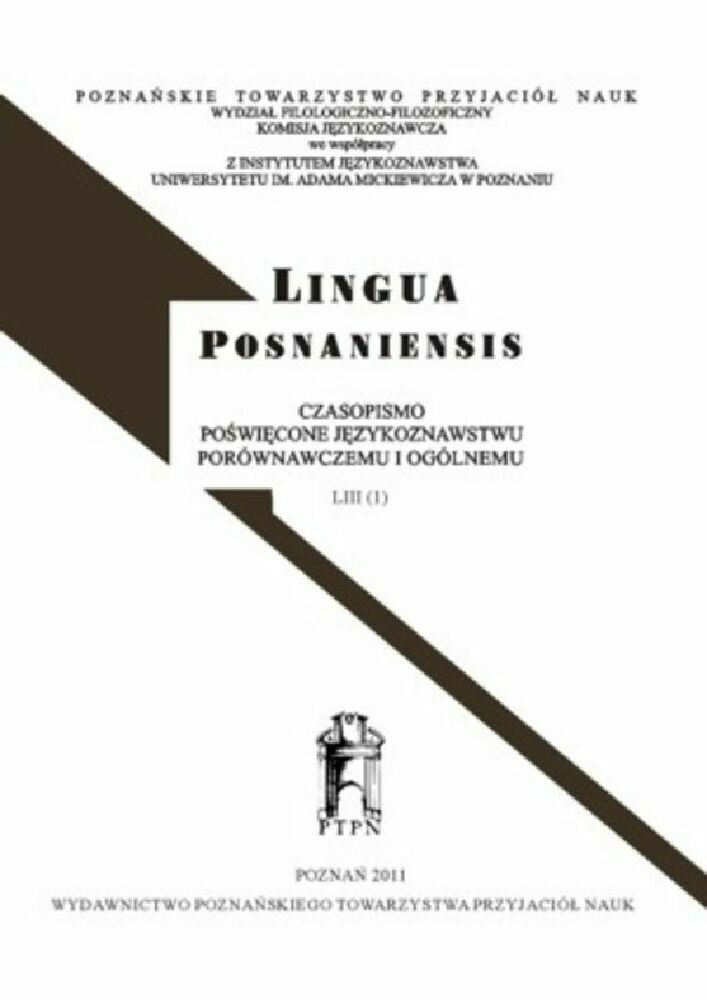Abstract
This paper presents a descriptive study of the control structures in Kokborok, a tibeto-Burman language spoken in tripura (one of the north-eastern states in India) and demonstrates the contact-induced changes in the phenomenon of control in Kokborok which resulted due to the long-term contact with Bangla (Indo-aryan), a genetically different language spoken in the state. the instances of genitive subject and the phenomenon of overt controllee in the embedded subject position in Kokborok are the cases in point. the instance of overt controllee described in this paper points to the deviation from the classic concept of pRo thereby demonstrating a property unique to the study of South asian languages.
References
Appel, R. & Muysken P. 2005. Language contact and bilingualism. Amsterdam: Amsterdam University Press.
Bhaskararao, P. & Subbarao, K.V. (eds.). 2004. Non-nominative subjects. Vols. I-II. Amsterdam, Philadelphia: John Benjamins.
Boeckx, C. & Hornstein, N. & Nunes, J. 2007. Overt copies in reflexive and control structures: A movement analysis. University of Maryland Working Papers in Linguistics 15. 1-45.
Chomsky, N. 1981. Lectures on government and binding. Dordrecht: Foris Publications.
Chomsky, N. & Lasnik, H. 1995. The theory of principles and parameters. In Chomsky, N. The minimalist program, 13-127. Cambridge, MA: MIT Press.
Fukuda, S. 2008. Backward control. Language and Linguistics Compass 2/1. 168-195.
Haddad, Y.A. 2007. Adjunct control in Telugu and Assamese. [Gainesville]: University of Florida. (Doctoral dissertation.)
Haddad, Y.A. 2011. Control into conjunctive participle clauses: The case of Assamese. Berlin, New York: De Gruyter Mouton.
Hornstein, N. 1999. Movement and control. Linguistic Inquiry 30. 69-96.
Karttunen, F. 1976. Uto-Aztecan and Spanish-type dependent clauses in Nahuatl. In Steever, S.F. & Walker, C.A. & Mufwene, S.S. (eds.). Papers from the Parasession on Diachronic Syntax, 150-58. Chicago: Chicago Linguistic Society.
Kayne, R. 1994. The antisymmetry of syntax. Cambridge, MA: MIT Press.
Lalitha Murthy, B. 1994. Participial constructions: A cross-linguistic study. New Delhi: Delhi University. (Doctoral dissertation.)
Landau, I. 2004. The scale of finiteness and the calculus of control. Natural Language & Linguistic Theory 22. 811-877.
Lee, F. 2003. Anaphoric R-expressions as bound variables. Syntax 6. 84-114.
Lee, K.Y. 2009. Finite control in Korean. Iowa City: University of Iowa. (Doctoral dissertation.)
Matras, Y. 2009. Language contact. New York: Cambridge University Press.
Nadkarni, M.V. 1975. Bilingualism and syntactic change in Konkani. Language 51. 672-83.
Nunes, J. 2001. Sideward movement. Linguistic Inquiry 31. 303-344.
Nunes, J. 2004. Linearization of chains and sideward movement. Cambridge, Massachusetts: Massachusetts Institute of Technology.
Nunes, J. 2011. The copy theory. In Boeckx, C. (ed.). The Oxford handbook of linguistic minimalism, 143-172. Oxford: Oxford University Press.
Polinsky, M. & Potsdam, E. 2006. Expanding the scope of control and raising. Syntax 9(2). 171-192.
Potsdam, E. 2006. Backward object control in Malagasy and principles of chain reduction. MS. University of Florida.
Roy, G. & Kumar, R. (In press). Embedded clauses in two varieties of Bangla. Chennai: Indian Institute Of Technology–Madras.
Sigurðsson, H.A. 1991. Icelandic case-marked PRO and the licensing of lexical arguments. Natural Language & Linguistic Theory 9. 327-363.
Sigurðsson, H.A. 2008. The case of PRO. Natural Language & Linguistic Theory 26. 403-450.
Spyropoulos, V. 2007. Finiteness and control in Greek. In Davies, W.D. & Dubinsky, S. (eds.). New horizons in the analysis of control and raising, 159-183. Dordrecht: Springer.
Subbārāo, K.V. 2012a. South Asian languages: A syntactic typology. New York: Cambridge University Press.
Subbārāo, K.V. 2012b. South Asian languages: A syntactic typology. (https://www.academia.edu/6666513/South_Asian_Languages_A_Syntactic_Typology) (Accessed on 2022-03-17.)
Subbārāo, K.V. 2017. Forward, backward, and partial copy control in Telugu. Indian Linguistics 78(1-2). 37-63.
Subbarao, K.V. & Hakacham, U.R. & Sarju Devi, T. 2007. Case-marked PRO: Evidence from Rabha, Manipuri, Hindi-Urdu and Telugu. In Bielmeier, R. & Haller, F. (eds.). Linguistics of the Himalayas and beyond, 291-322. Berlin: Mouton de Gruyter.
Thomason, S.G. 2001. Language contact: An introduction. Edinburgh: Edinburgh University Press.
License
Copyright (c) 2022 Gargi Roy, Rajesh Kumar, Kārumūri V. Subbārāo

This work is licensed under a Creative Commons Attribution-NonCommercial-NoDerivatives 4.0 International License.
